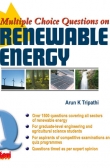Emerging Energy Alternatives for Sustainable Environment
Book Details
Sustainability of environment is an emerging global issue at present. Unsustainable or deteriorating environment is a matter of concern as it has threatened the survival of living creatures. Recently, climate change has been matter of great concern at a global platform owing to imbalances in natural environment. Increasing population has increased the demand for energy, which has ultimately put pressure on natural resources and caused a paradigm shift from resource generation to exploitation.
Emerging Energy Alternatives for Sustainable Environment aims to address the role of sustainable technologies in energy generation options for clean environment. It covers a wide spectrum of energy generation approaches, with an emphasis on five key topics: (i) renewable energy sources and recent advances, (ii) emerging green technologies for sustainable development, (iii) assessment of biomass for sustainable bioenergy production, (iv) solid waste management and its potential for energy generation, and (v) solar energy applications, storage system, and heat transfer.
This book provides essential and comprehensive knowledge of green energy technologies with different aspects for engineers, technocrats and researchers working in the industry, universities, and research institutions. The book is also very useful for undergraduate and graduate students of science and engineering who are keen to know about the development of renewable energy products and their corresponding processes.
Target Audience
-
Engineers and Technocrats working in the renewable energy industry and researchers
Table of Contents
- Biogas Potential in India: Production, Policies, Problems, and Future Prospects
- Membrane-less Microbial Fuel Cell: A Low-cost Sustainable Approach for Clean Energy and
- Hydrogen Energy: Present and Future
- Emerging Energy Alternatives for Sustainable Development in Malaysia
- Role and Initiatives of Indian Government Policies for Growth of Wind Energy Sector
- Improved Technology for Non-edible Seed Oils: Sources for Alternate Fuels
- Adsorption and photodegradation of sulfamethoxazole in a three-phase fluidized bed reactor
- Application of Cellulose Nitrate Membrane for Pervaporative Separation of Organics from Water
- Green Chemistry: Mitigatory Measure for Environmental Pollution
- Building Energy Simulation for Improved Thermal Performance: A CFD Approach
- Cyanobacterial Biomass – A Tool for Sustainable Management of Environment
- Low-cost Production of Algal Biofuel from Wastewater and Technological Limitations
- Physical and Chemical Exergy Analysis and Assessment of Biogas as an Energy Source in Hybrid Cooling Machine
- Lignocellulosic Biomass to Bioenergy Production: Process and Techniques for Biomass Assessment
- Municipal Solid Waste Management in India: Present Status and Energy Conversion Opportunities
- Organic Superfluous Waste as a Contemporary Source of Clean Energy
- Vermicomposting: A Potential Tool for Sustainable Management of Solid Waste
- Biogas Potential from Sewage Treatment Plant and Palm Oil Mill Effluent for Electricity Generation in Malaysia
- Passive Energy in Residential Buildings
- Solar Photocatalytic Treatments of Wastewater and Factors Affecting Mechanism: A Feasible Low-cost Approach
- Advancement in Phase Change Materials for Solar Thermal Energy Storage
- Earth to Air Heat Exchanger Systems for Small Houses and Industrial Buildings in Changing Indian Climatic Conditions
- Development in Metal Oxide Nanomaterial-based Solar Cells
Preface
1.1 Introduction
1.2 Production of Biogas
1.3 Sources/Materials for Biogas Production
1.4 Roles of Microbes in Production of Biogas
1.5 Issues and Concerns for the Biogas production Process
1.6 Augmentation/Upgradation of Biogas Process
1.7 Types of Biogas Reactors
1.8 Policies Related to Biogas Production in India
1.9 Benefits of Biogas Energy Production—Potential in India
1.10 Problems and Issues Encountered
1.11 Future Prospects for Biogas in India
1.12 Conclusion
References
Environment
2.1 Introduction
2.2 Basic requirements for Membrane-less Microbial Fuel Cell
2.3 Classification of Membrane-less Microbial Fuel Cell
2.4 Conclusion
Acknowledgements
References
3.1 Introduction
3.2 Hydrogen Production
3.3 Storage Technologies for Hydrogen
3.4 Hydrogen Energy and Environment
3.5 Hydrogen and Other Alternative Secondary Energies
3.6 Hydrogen Safety
3.7 Future Prospects of Hydrogen
References
4.1 Introduction
4.2 Renewable Resources in Malaysia
4.3 Conclusion
References
5.1 Introduction
5.2 India’s Wind Energy Potential and installation
5.3 Indian Government Policies for Wind Energy Sector
5.4 State Government Policies for Wind Energy Sector
5.5 Conclusion
References
6.1 Introduction
6.2 Materials and methods
6.3 Results and discussion
6.4 Conclusion
References
7.1 Introduction
7.2 Methodology
7.3 Results and discussion
7.4 Conclusion
Acknowledgements
References
8.1 Introduction
8.2 Experimental Set-up
8.3 Results and Discussion
8.4 Conclusion
Acknowledgements
References
9.1 Introduction
9.2 Green Chemistry Concept
9.3 History
9.4 A Timeline of Green Chemistry Highlights
9.5 Scope
9.6 Principles
9.7 Role of Green Chemistry in Prevention and control of Pollution
9.8 Environmental Sustainability
9.9 Conclusion
References
Websites
10.1 Introduction
10.2 Thermal Mass and Building Design
10.3 Building Energy Analysis
10.4 Necessity for Building Simulation
10.5 Application of Building Simulation and Systems Approach
10.6 Software
10.7 Applications of Cfd for Building Design
10.8 Conclusion
References
11.1 Introduction
11.2 Approaches to biofertilizer application
11.3 Cyanobacteria: a biofertilizer
11.4 Nitrogen Fixation
11.5 Cyanobacteria: a nutrient source
11.6 Cyanobacteria: a pesticide tolerant
11.7 Cyanobacteria: a salinity tolerant
11.8 Cyanobacteria: a bioremediation tool
11.9 Cyanobacteria: a CO2 sequestration agent
11.10 Nutrient management system
References
12.1 Introduction
12.2 Classification of Algae
12.3 Factors Affecting Growth of Microalgae
12.4 Sink for Carbon dioxide
12.5 Wastewater as a Resource for Algal Growth
12.6 Microalgae Cultivation Methods
12.7 Harvesting Technologies for Algal Biomass
12.8 Lipid Synthesis in Microalgae
12.9 Conversion Technologies for Algal Biofuel
12.10 Limitations with Biomass/Biofuel Production
12.11 Conclusion
References
13.1 Introduction
13.2 System Description and Working Principle
13.3 Thermal Analysis of Biogas Boiler
13.5 Thermodynamic Analysis
13.6 Results and Discussion
13.7 Conclusion
References
14.1 Introduction
14.2 Process of Biomass Deconstruction
14.3 Techniques for Assessment of Biomass Breakdown
14.4 Current Challenges and Future Prospects
References
15.1 Introduction
15.2 Overview of Municipal Solid Waste management in India
15.3 Opportunities for Energy Conversion
15.4 Challenges
15.5 The Way Forward
15.6 Conclusion
Acknowledgements
References
16.1 Introduction
16.2 Current status of energy
16.3 Bioenergy
16.4 Organic waste
16.5 Technology for energy
16.6 Microbial Fuel cell
16.7 MFC components
16.8 Bio-battery
16.9 Remote power Source
16.10 Effective for sea water
16.11 Conclusion
Acknowledgements
References
17.1 Introduction
17.2 Classification and Composition of Solid Waste
17.3 Current Strategies used for Solid Waste Management in India
17.4 Earthworms
17.5 Vermicomposting Process
17.6 Vermicompost and Earthworm Harvesting
17.7 Composition of Vermicompost
17.8 Advantages and Disadvantages of Vermicompost
17.9 Applications of Vermicomposting
17.10 Conclusion
References
18.1 Introduction
18.2 Renewable Energy Status in Malaysia and Malaysian Renewable Energy Target
18.3 Feed-in Tariff in Malaysia
18.4 Malaysian Palm Oil Industry
18.5 Biogas Potential in Palm Oil Mills
18.6 Malaysian Sewerage Treatment
18.7 Typical Sewage Treatment Plant with Anaerobic digester Scenario in Malaysia
18.8 Biogas Potential at Stp
18.9 Co-digestion of Pome with Ss
18.10 Impact of Biogas Recovery on Sustainability
18.11 Conclusion
Acknowledgements
References
19.1 Introduction
19.2 Passive Solar Cooling
19.3 Methodology
19.4 Estimation of Energy Cost
19.5 Conclusion
References
20.1 Introduction
20.2 Solar Spectrum
20.3 Design of Solar Photocatalytic Reactors
20.4 Photocatalytic (Solar) Treatment of Pollutant
20.5 Factors Affecting Solar Photocatalysis
20.6 Recommended Analytical Methods
20.7 Economical Assessment
20.8 Conclusion
References
21.1 Introduction
21.2 Phase Change Materials
21.3 Application of Pcms
21.4 Conclusion
References
22.1 Introduction
22.2 Changing Indian Climatic Conditions
22.3 Indian Climate and Eahe Systems
22.4 Demand for Energy in India
22.5 Advantages of Eahe System
22.6 Design of Eahe Systems
22.7 Components of Eahe System
22.8 Performance of Eahe System
22.9 Conclusion
References
23.1 Introduction
23.2 History of Solar Cell
23.3 Metal Oxide Nanomaterials
23.4 Three Generations of Development
23.5 Nanomaterial-based Solar Cell Research
23.6 Thin Film Solar Cells
23.7 Applications and Implementations
23.8 Polymer Solar Cells
23.9 Pv Industry Goal: Reduce Cost of Energy
23.10 Conclusion
References
Index
About the Editors
Keywords
You may also like...
-
 Books for MNRE Scientist-B (Group A - Gazetted) Exam
Regular Price 550.00
Special Price 550.00
Books for MNRE Scientist-B (Group A - Gazetted) Exam
Regular Price 550.00
Special Price 550.00
-
 Innovation for Sustainable Development
Regular Price 655.00
Special Price 590.00
Innovation for Sustainable Development
Regular Price 655.00
Special Price 590.00
-
 Multiple Choice Questions on Renewable Energy
Regular Price 395.00
Special Price 356.00
Multiple Choice Questions on Renewable Energy
Regular Price 395.00
Special Price 356.00


